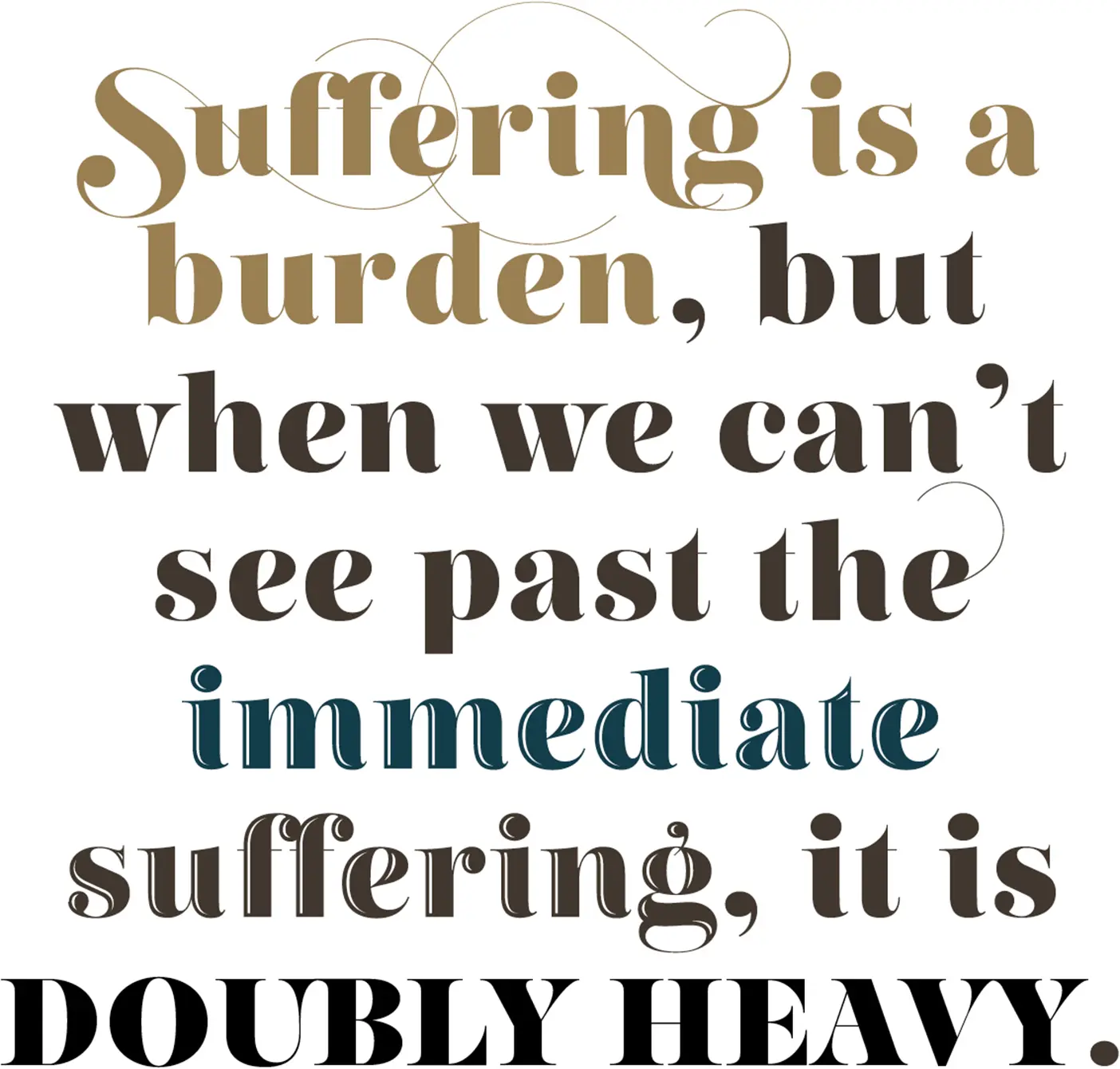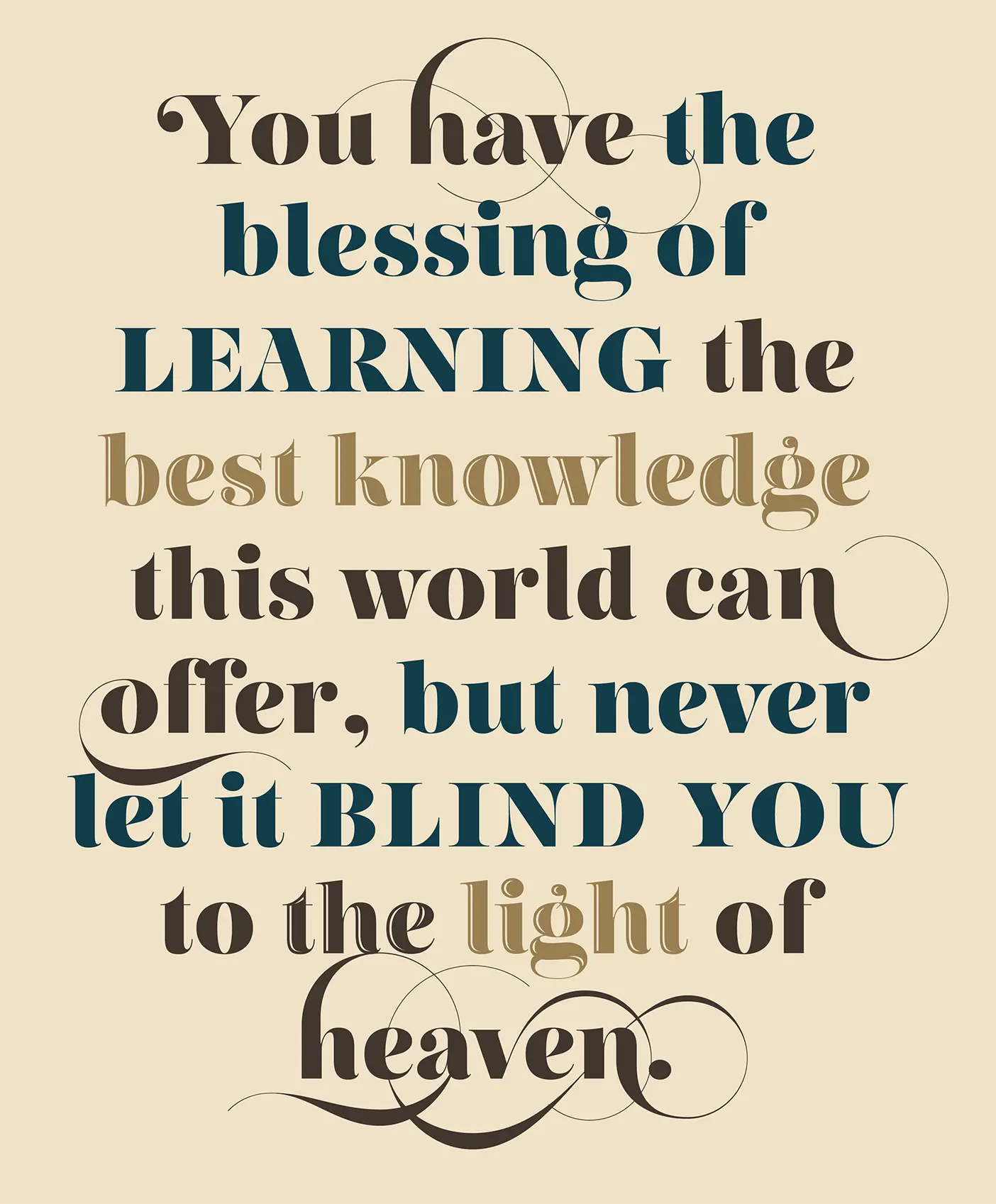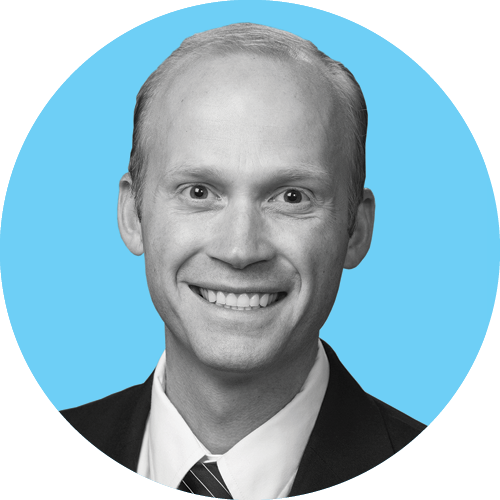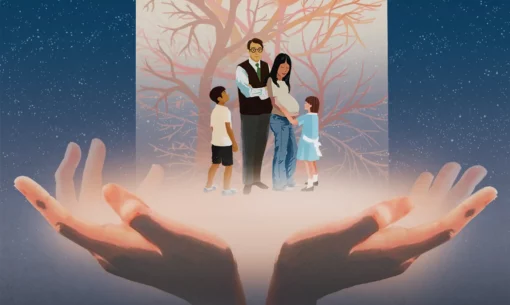Christ’s Light Burden

Christ’s Light Burden
Every choice in life comes with burden, but Christ’s burden is light.
By W. Justin Dyer (BS ’04)in the Fall 2023 issue
Illustrations by Mark Smith
In striving to live a religious life that reflects the teachings of Jesus Christ, we have all felt the burdens of discipleship—such as learning how to forgive as the Savior would, struggling to maintain good religious habits, and feeling like you are not measuring up in keeping the commandments. I often think back to a younger version of myself—one who is newly experiencing some of these burdens, seeing others struggle, and wondering whether bearing the burdens of living a religious life is really worth it.
Some see religious burdens as harmful. There are books entitled The God Delusion¹ and God Is Not Great: How Religion Poisons Everything.² Many have argued that religion is long past its usefulness—and encourage us to abandon its burdens for a better, freer, more advanced life.³ We see some people following these increasingly loud voices away from religion.
Yet Jesus taught that His yoke is easy and His burden is light (see Matt. 11:30). But clearly the Savior experienced many difficulties. There must have been something about His burden that led Him to choose to hold to it. What is it that makes bearing Christ’s burden worth everything?
Every Choice Is Imbued with Burden
First, we should understand that everyone must carry a burden of one form or another. Every choice is imbued with burden. And we decide what is worth carrying.

Jesus asked the rich man to put down his burden of riches and take up His burden. Jesus said, “Sell whatsoever thou hast . . . : and come, take up the cross, and follow me” (Mark 10:21).
Christian philosopher Søren Kierkegaard noted, “One bears a yoke of iron, another a yoke of wood, a third a golden yoke, a fourth the heavy yoke, but only the Christian bears—the yoke that is good!”4 Kierkegaard’s idea that the Christian’s yoke, or Christ’s yoke, is “good” or “light” seems to mean more than it simply weighing less than burdens of iron or wood or gold. His burden is light because when we take it up, we bear it with Christ, and then His grace, His enabling power, comes to us.
President Russell M. Nelson has said:
Religion and Research
But some experiences we have seem to suggest that religious burdens are, at times, crushing rather than enabling. Probably all of us know some people who assume that the burden of a religious life is harmful. When I first started teaching the Eternal Family course, I was often asked how Latter-day Saints’ mental health compared to the mental health of those of other faith traditions or those of no faith.

So for the past seven years I have turned my research to studying this. Some research had already been done, but there was still a lot we didn’t know. My colleagues and I have crunched data on hundreds of thousands of people, including Latter-day Saints and non–Latter-day Saints, religious and nonreligious people, those living in Utah and those living around the United States, and people across sexual orientations and gender identities. With our work and the work of others, an important picture has begun to emerge.
It is important to know that general trends found in research should not be used to dismiss anyone’s personal experience: we should recognize and empathize with whatever experience a person has. However, recognizing these general trends has helped me understand my own experiences of living my religion and has provided me with a few insights into what choosing Christ’s light burden means.
Research on religion and mental health goes back 120 years.6 And the evidence amassed since then is rather clear: attending religious services and engaging in other religious and spiritual practices are, on average, related to better mental health.7 They are related to more volunteering in the community8 and, in general, better physical health.9 They are also related to greater family happiness, better parenting, and lower likelihood of divorce, particularly when family relationships are seen as divine and connected to God.10 A global study also found that men who are more religious do more housework11—something not bad to consider when choosing a spouse. The reality is that research on the whole shows that religious people are better off across nearly every conceivable domain.12
And this seems to be more than just correlation: Berkeley researchers have concluded that the accumulated evidence makes a compelling case for a causal link between religious and spiritual practices and good mental health.13
What about LGBT individuals—who may be of particular concern, given the higher rates of mental-health difficulties in this population? (I am using LGBT to mean all sexual and gender minority experiences.) How might religion be related to their mental health? Although the research is more nuanced, taken as a whole, studies suggest that just as in the general population, LGBT individuals who have greater connections to religion or spirituality have, on average, fewer mental-health difficulties.14
You are probably aware that mental-health problems have soared in the last few years while religious and spiritual practices have plummeted. The obvious question researchers have begun asking is whether these trends are connected. Harvard professor Tyler J. VanderWeele and his colleagues estimated “that nearly 40% of the increase in the suicide rate could be attributed to the decline in religious service attendance.”15 This is an important and telling research finding. At the same time—and perhaps this is particularly felt by those of us whose lives have been touched by the suicide of a loved one—we do not want this to be oversimplified. There are so many aspects of suicide to consider. If anyone is struggling, please reach out and let others help lighten your burdens.

What about research specifically on Latter-day Saints? My colleagues and I recently conducted a review of every study on Latter-day Saint mental health published in the last 20 years.16 It probably won’t surprise you that Latter-day Saints tend to be a highly religious group, engaging more in their religion than almost any other group.17 And that seems to translate into good things. Although this research area is still new, studies generally find that Latter-day Saints’ mental health is just as good as and often better than the mental health of those of other religions or of no religion.18
And what about LGBT Latter-day Saints? Large-scale, representative studies have found that Latter-day Saint LGBT individuals have, on average, just as good and almost always better mental health compared to LGBT individuals of other religions or of no religion.19
In talking about all this research, let me make just two notes. First, there are instances when religion may not be related to better mental health. I will touch on that later, and helpful sources are provided in the footnotes. Second, when we are looking at this research, it is important to know we are not proving whether the gospel is true. That comes from a witness of the Holy Spirit. What is at stake is a better understanding of what is helpful to people and how we can best serve them. And so it is important to recognize the overall trend that religious people have something that is related to better mental health.
Yet it can be difficult to reconcile these big-picture findings when we know that so many Latter-day Saints struggle with their mental health. It is clear that we still have a lot of work to do.
How Religion Bears Us Up
To understand why religion is generally related to better mental health, we must recognize that all people experience trials. Again, we all carry burdens of one form or another. Paul said, “There hath no temptation taken you but such as is common to man.” Our trials are trials shared with the whole human race, whether religious or not. “But,” Paul added, “God is faithful . . . [and will] make a way to escape, that ye may be able to bear it” (1 Cor. 10:13; emphasis added). When we are connected to God, He provides a way to bear the burden. Amidst all the burdens we can choose, when we have faith to choose the Savior’s light burden, God bears us up.
There are many ways in which religion can help bear us up. Three that I want to emphasize are (1) a community of covenant caring, (2) an eternal perspective, and (3) divine patterns of living.
A Community of Covenant Caring
Religion provides not just community but a community of covenant caring. When his people wanted to come into the fold of God, Alma the Elder said they must be “willing to mourn with those that mourn; yea, and comfort those that stand in need of comfort” (Mosiah 18:9) and “bear one another’s burdens, that they may be light” (Mosiah 18:8 ; emphasis added). To a large extent, God’s fold—His Church—is about taking on the burden of making our brothers’ and sisters’ burdens light.
President Nelson has said:
Everyone has pain somewhere, and our challenge is to find out where the pain is. Usually it’s not physical pain but comes in the stress of living. . . . This is what we try to teach the missionaries. When you meet someone, find out how we can help them. . . . The gospel exists to help people.20
The Church’s General Handbook outlines many aspects of our covenant-caring responsibility, including this responsibility: “The Church encourages families and members to reach out with sensitivity, love, and respect to persons who are attracted to others of the same sex.”²¹
Are there Church members who treat others poorly? Tragically there are. But true religion calls us to lighten burdens. As President Nelson said in April’s general conference, “Charity propels us ‘to bear one another’s burdens’ rather than heap burdens upon each other.”²² We must choose the light burden of lightening each others’ burdens.
An Eternal Perspective
Along with a community of covenant caring, the eternal perspective that religion provides can lighten burdens.
When Joseph Smith, in his own suffering, pled for himself and for the suffering Saints, God comforted him with an eternal perspective, saying “that all these things shall give thee experience, and shall be for thy good” and “if thou endure it well, God shall exalt thee on high” (D&C 122:7). The Lord helped Joseph see past the immediate suffering to a glorious future.
Suffering is a burden, but when we can’t see past the immediate suffering, it is doubly heavy. Kierkegaard gave an analogy of a rich man driving a lavish carriage at night with lamps all around. He could see what was right in front of him, but his lights blinded him to the stars. Yet a poor peasant with no lights had a splendid view of the heavens.²³
You have the blessing of learning the best knowledge this world can offer, but never let it blind you to the light of heaven. We may feel claustrophobic relying on our own limited light—seeing only the heavy burden right in front of us. Choosing an eternal perspective helps lift our burdens.
Divine Patterns of Living
Along with a community of covenant caring and an eternal perspective, religion offers divine patterns of living: commandments and covenants. These divine patterns enable us and keep us from the heavy burdens the natural man would have us carry. You won’t be surprised to learn that religious people, particularly Latter-day Saints, are less likely to drink, smoke, use drugs, and have unhealthy sexual behaviors.24
The patterns of the Church Educational System Honor Code are a burden to many. But aspects of the law of chastity embedded in the Honor Code are a light burden, especially when we realize that the Centers for Disease Control and Prevention reports that one in five Americans has a sexually transmitted infection.25 This is to say nothing of other difficulties that come from noncommitted sexual relationships. Research finds that the more sexual partners one has, the greater the risk of developing mental difficulties and engaging in substance abuse.26
And regarding the Word of Wisdom embedded in the Honor Code, a report from last year found that more than half of all “people involved in serious or fatal road accidents tested positive for drugs or alcohol.”27
Choosing the light burden of the Honor Code puts you in one of the safest places physically, emotionally, mentally, and spiritually. Of course BYU students who follow the Honor Code still struggle with their own trials. But there is a profound blessing that comes from attending a university that chooses the light burden of religion.
Choosing to live divine patterns does bring a burden of accountability to those patterns. But there must be accountability, or there is no commitment. I am grateful for accountability to my religion because it reinforces what I most desire. The burdens, freely chosen, are light because they help me become who I truly want to be and who the Lord would have me be.
Carrying the Light Burden Heavily
At this point let me mention some instances when religion may feel heavy.
The first is when we are religious simply to avoid something bad, we don’t want to disappoint someone, or we want to avoid criticism and shame. When we are religious simply to avoid something bad, we live our whole lives like terrified Bilbo Baggins when he anxiously snuck into the mountain trying not to wake the dragon.28 But when we are religious because it is important to us, because it is part of our identity, because we value it, and because we love the Lord and the opportunities religion gives us to lift others, then the burden is light.
Religion may also feel heavy when we think of it as being transactional rather than transformational. When it is transactional, we see ourselves putting our religious acts into a spiritual vending machine and expecting the instant, proper payout. And we get angry and start kicking at the machine when it seems the owed spiritual blessings have gotten stuck and don’t appear. The burden is light when we see religion as transformational, thinking of our religious acts as helping us little by little, line by line, to become more like the Savior.²9

Religion may also seem heavy when we feel it is wrong to experience doubts. Doubts will come to many of us at one point or another, and when we see them as opportunities for growth, the burden is light.
Religion can also feel heavy when we see God as cruel rather than compassionate, impersonal rather than personal, or apathetic rather than sympathetic—when we feel He is out of reach.
A few years ago a woman in my ward shared the following in sacrament meeting, and I share it with her permission. She said:
One of the most pervasive things I remember from living
with my father is his sternness and his temper. . . . I loved my dad and I knew he loved me, yet I experienced fear when he was around. For many years I saw Heavenly Father the same way I saw my own father—as someone who, for the most part, kept his distance and was easily disappointed and frustrated at my weakness.
This sister then described what she did to help make this heavy burden light:
I have asked God many times to show me who He really is and to help me shed all my misconceptions and false beliefs so I can experience the real Him. He has responded with patience and love beyond my expectations. He has taken me by the hand, and I am slowly learning to trust that He is not distant but right here next to me. He is slowly walking me out of fearing Him and into the saving power of His love.
Our experiences may influence how we see God and religion. But when we come to know and experience God’s true, infinitely loving nature, our burdens become light.
Religion may also feel heavy when we believe we must live it perfectly rather than patiently.³0 President Nelson said:
Be patient with yourself. Perfection comes not in this life but in the next life. Don’t demand things that are unreasonable but demand of yourself improvement. As you let the Lord help you through that, He will make the difference.³¹
While it is unhealthy to place perfectionist demands on ourselves, we must recognize that the light burden of religion stretches us in healthy ways. We will feel the strain on occasion, and that’s good—we are growing. Don’t run away from it. But we need wisdom and the Spirit to know where to place our efforts (see Mosiah 4:27).
The Pilgrim’s Progress
There will come times when we are not sure just how to carry the burden of religion lightly rather than heavily. There is a story that was written about 350 years ago entitled The Pilgrim’s Progress. It is an extended allegory in which a man named Christian has a great burden on his back, and he cannot shed it. But when Christian enters the path to the Celestial City, he sees the cross and his heavy burden falls off. He takes up the burden of the path and has many adventures on his way to the Celestial City.³²
At one point Christian comes to a fork in the path. He sits confused, not knowing which is the way. Then a person in bright, shining clothes greets him and tells him he knows the way, and Christian follows. All of a sudden this person captures Christian in a net and leaves him for dead. He is freed by someone from the Celestial City.

Christian wonders what he did wrong. He had followed someone who seemed to know the way. The person from the Celestial City says that Christian had followed the Flatterer and reminds Christian that he had been given a note that would have directed him at the fork. Christian was given everything he needed, but he had forgotten.³³
Like Christian, most, if not all, of us will come to a fork in the path—a choice—in how we live our religion. Either path will lead to a burden. The question is, which one leads to the light burden, to Christ’s burden?
May I suggest three notes to guide us to the Celestial City: they are the documents “The Living Christ: The Testimony of the Apostles,”34 the bicentennial proclamation “The Restoration of the Fulness of the Gospel of Jesus Christ,”35 and “The Family: A Proclamation to the World.”36 These three one-page documents are the united voice of Christ’s apostles: the First Presidency and the Quorum of the Twelve. When we are unsure of which way to go, we can take these documents out.
President Nelson said, “This path is rigorous and at times will feel like a steep climb.”37 But he reminded us of the
blessed and happy state of those that keep the commandments of God. For behold, they are blessed in all things, both temporal and spiritual; and if they hold out faithful to the end they are received into heaven.38
Many of the mental difficulties we experience come through no fault of our own but simply because we live in a fallen world and our bodies are subject to physical and mental sickness. If we experience such difficulties, we should be careful not to label ourselves as worthless or less than or just somehow weak.
Please don’t hear me saying that if you were only more religious you wouldn’t have mental-health challenges. But do hear me saying that we must recognize the wonderful blessings within religion, even with all the imperfections of the people in it. Do hear me saying that we should rejoice, for Christ’s Church has come (see John 14:27). Christ is faithful and has blessed us with a church designed to help us bear our burdens. The Church is a manifestation of “the love Jesus offers [us]” and “the grace that so fully He proffers [us].”39 Knowing of His infinite love can persuade us to move forward with infinite hope.
All choices bring burdens. Aligning our choices with Christ—with His Church and His apostles—is the light burden. To bear the name of Christ is a choice to have faith in Him and to yoke ourselves with Him who bears our burdens, our sins, our sorrows, and our griefs. It is a choice to allow Him to do for us what He offered to ancient Israel: to bear us “on eagles’ wings” and bring us home (Ex. 19:4).

This text is condensed from a devotional address delivered on May 23, 2023, by W. Justin Dyer, BYU professor of religious education. Find the full text, audio, and video at speeches.byu.edu.
Feedback Send comments on this article to magazine@byu.edu.
NOTES
- See Richard Dawkins, The God Delusion (Boston: Houghton Mifflin Company, 2006).
- See Christopher Hitchens, God Is Not Great: How Religion Poisons Everything (New
York: Twelve Hachette Book Group, 2009). - For an example, see Sigmund Freud, The Future of an Illusion (1928).
- Søren Kierkegaard, Gospel of Sufferings, trans. A. S. Aldworth and W. S. Ferrie (Cambridge: James Clarke and Company, 1955), 37.
- Russell M. Nelson, “Overcome the World and Find Rest,” Liahona, November 2022.
- See Émile Durkheim, Le Suicide: Étude de Sociologie (Paris: Ancienne Librairie Germer Baillière et Cie, 1897); first published in English as Suicide: A Study in Sociology, trans. John A. Spaulding and George Simpson (New York: Free Press, 1951).
- See Harold G. Koenig, Religion and Mental Health: Research and Clinical Applications (London: Academic Press, 2018); see also David H. Rosmarin and Harold G. Koenig, eds., Handbook of Spirituality, Religion, and Mental Health,2nd ed. (London: Academic Press, 2020).
- See Robert D. Putnam and David E. Campbell, American Grace: How Religion Divides and Unites Us (New York: Simon and Schuster, 2010).
- See Lynda H. Powell, Leila Shahabi, and Carl E. Thoresen, “Religion and Spirituality: Linkages to Physical Health,” American Psychologist 58, no. 1 (January 2003): 36–52.
- See Annette Mahoney, Daniel D. Flint, and James S. McGraw, “Spirituality, Religion, and Marital/Family Issues,” in Rosmarin and Koenig, Handbook of Spirituality, 159–78; see also Edna Brown, Terri L. Orbuch, and Jose A. Bauermeister, “Religiosity and Marital Stability Among Black American and White American Couples,” Family Relations 57, no. 2 (April 2008): 186–97.
- See Bethany Gull and Claudia Geist, “Godly Husbands and Housework: A Global Examination of the Association Between Religion and Men’s Housework Participation,” Social Compass 67, no. 3 (September 2020): 389–409.
- For more information specifically on Utah and mental health, as well as LGBT mental health, see W. Justin Dyer and Michael A. Goodman, “Sexuality, Religion, and Mental Health,” Brigham Young University presentation, March 2022, foundations.byu.edu/00000183-e77a-d2ff-a7b3-ffff7e0b0001/religion-sexual-orientation-and-mental-health-byu-presentation.
- See Doug Oman and S. Leonard Syme, “Weighing the Evidence: What Is Revealed by 100+ Meta-Analyses and Systematic Reviews of Religion/Spirituality and Health?” in Doug Oman, ed., Why Religion and Spirituality Matter for Public Health: Evidence, Implications, and Resources (Cham, Switzerland: Springer, 2018), 261–82.
- See G. Tyler Lefevor, Edward B. Davis, Jaqueline Y. Paiz, and Abigail C. P. Smack, “The Relationship Between Religiousness and Health Among Sexual Minorities: A Meta-Analysis,” Psychological Bulletin 147, no. 7 (July 2021): 647–66.
- Tyler J. VanderWeele, Shanshan Li, and Ichiro Kawachi, “Religious Service Attendance and Suicide Rates—Reply,” Letters: Comment and Response, JAMA Psychiatry 74, no. 2 (February 2017): 198.
- See William Justin Dyer, Daniel K. Judd, Megan Gale, and Hunter Gibson Finlinson, “Religion, Mental Health, and the Latter-day Saints: A Review of Literature 2005–2022,” Religions 14, no. 6 (June 2023): article 701.
- See Christian Smith and Melinda Lundquist Denton, Soul Searching: The Religious and Spiritual Lives of American Teenagers (New York: Oxford University Press, 2005).
- See Dyer, Judd, Gale, and Finlinson, “Religion”; see also Daniel K. Judd, “Religiosity, Mental Health, and the Latter-day Saints: A Preliminary Review of Literature (1923–95),” in James T. Duke, ed., Latter-day Saint Social Life: Social Research on the LDS Church and Its Members (Provo: BYU Religious Studies Center, 1998), 473–97.
- See W. Justin Dyer and Michael A. Goodman, “Religious Affiliation’s Association with Suicidality Across Sexual Orientations and Gender Identities,” Religions 13, no. 10 (October 2022): article 932; W. Justin Dyer, Michael A. Goodman, and David S. Wood, “Religion and Sexual Orientation as Predictors of Utah Youth Suicidality,” BYU Studies Quarterly 61, no. 2 (2022): 51–103; James S. McGraw, Meagan Docherty, Jay R. Chinn, and Annette Mahoney, “Family, Faith, and Suicidal Thoughts and Behaviors (STBs) Among LGBTQ Youth in Utah,” Psychology of Sexual Orientation and Gender Diversity 10, no. 2 (June 2023): 257–68; and Jared S. Klundt, David M. Erekson, Austin M. Lynn, and Hannah E. Brown, “Sexual Minorities, Mental Health, and Religiosity at a Religiously Conservative University,” Personality and Individual Differences 171 (March 2021): article 110475.
- Russell M. Nelson; quoted in Sheri L. Dew, Insights from a Prophet’s Life: Russell M. Nelson (Salt Lake City: Deseret Book, 2019), 189.
- “Same-Sex Attraction and Same-Sex Behavior,” General Handbook: Serving in The Church of Jesus Christ of Latter-day Saints, July 2021 (Salt Lake City: Church of Jesus Christ, 2021), 38.6.15 (p. 409); see also “Transgender Individuals,” General Handbook, 38.6.23 (p. 413).
- Russell M. Nelson, “Peacemakers Needed,” Liahona, May 2023; quoting Mosiah 18:8.
- Kierkegaard, Gospel of Sufferings, 116.
- See Hilary S. Connery and Jeff Devido, “Spirituality/Religion and Substance Use Disorders,” in Rosmarin and Koenig, Handbook of Spirituality, 119–38; see also Steven E. Barkan, “Religiosity and Premarital Sex in Adulthood,” Journal for the Scientific Study of Religion 45, no. 3 (September 2006): 407–17.
- See “CDC Estimates 1 in 5 People in the U.S. Have a Sexually Transmitted Infection,” Newsroom, Centers for Disease Control and Prevention (CDC), 25 January 2021, cdc.gov/media/releases/2021/p0125-sexualy-transmitted-infection.html; see also “U.S. STI Epidemic Showed No Signs of Slowing in 2021—Cases Continued to Escalate,” Newsroom, CDC, 11 April 2023, cdc.gov/media/releases/2023/s0411-sti.html.
- See Wyndol Furman and Charlene Collibee, “Sexual Activity with Romantic and Nonromantic Partners and Psychosocial Adjustment in Young Adults,” Archives of Sexual Behavior 43, no. 7 (October 2014): 1327–41; see also Sandhya Ramrakha, Charlotte Paul, Melanie L. Bell, Nigel Dickson, Terrie E. Moffitt, and Avshalom Caspi, “The Relationship Between Multiple Sex Partners and Anxiety, Depression, and Substance Dependence Disorders: A Cohort Study,” Archives of Sexual Behavior 42, no. 5 (July 2013): 863–72.
- Jen Christensen, “More Than Half of People Involved in Road Accidents Had Drugs or Alcohol in Their System, Study Says,” CNN Health, 14 December 2022, cnn.com/2022/12/14/health/drug-alcohol-driving/index.html; citing Alcohol and Drug Prevalence Among Seriously or Fatally Injured Road Users, National Highway Traffic Safety Administration, December 2022, report no. DOT HS 813 399.
- See chapter 12, “Inside Information,” in J. R. R. Tolkien, The Hobbit, or There and Back Again (1937).
- See Isa. 28:10, 13; 2 Ne. 28:30; D&C 98:12; see also D&C 50:24.
- It is important to acknowledge a condition known as scrupulosity, which is a type of obsessive-compulsive anxiety disorder surrounding religion. Those with scrupulosity suffer from crippling bouts of anxiety over religious or moral issues to the point that they have constant spiritual anxiety. Their anxiety is so strong that it leads to maladaptive behaviors. This type of mental health disorder can truly be heavy, but it can be alleviated by meeting with a qualified professional. See Debra Theobald McClendon, “Understanding Scrupulosity (Religious OCD),” Digital Only: Young Adults, Ensign, September 2019, churchofjesuschrist.org/study/eng/ensign/2019/09/young-adults/understanding-scrupulosity-religious-ocd.
- Russell M. Nelson, excerpt from Men’s Hearts Shall Fail Them, Church of Jesus Christ, 18 November 2011, YouTube video, 2:22–49, youtube.com/watch?v=EMwKxmTLaCs.
- See John Bunyan, The Pilgrim’s Progress (1678), part 1.
- See Bunyan, Pilgrim’s Progress, part 1, 178–81.
- See “The Living Christ: The Testimony of the Apostles” (1 January 2000).
- See “The Restoration of the Fulness of the Gospel of Jesus Christ: A Bicentennial Proclamation to the World,” 5 April 2020; introduced in Russell M. Nelson, “Hear Him,” Ensign, May 2020.
- See “The Family: A Proclamation to the World” (23 September 1995).
- Russell M. Nelson, “The Power of Spiritual Momentum,” Liahona, May 2022; see 2 Ne. 31:18–20.
- Mosiah 2:41; quoted in Nelson, “Spiritual Momentum.”
- “I Stand All Amazed,” Hymns, 2002, no. 193.




